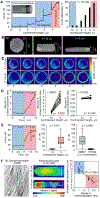The nucleus acts as a ruler tailoring cell responses to spatial constraints
- PMID: 33060332
- PMCID: PMC8059074
- DOI: 10.1126/science.aba2894
The nucleus acts as a ruler tailoring cell responses to spatial constraints
Abstract
The microscopic environment inside a metazoan organism is highly crowded. Whether individual cells can tailor their behavior to the limited space remains unclear. In this study, we found that cells measure the degree of spatial confinement by using their largest and stiffest organelle, the nucleus. Cell confinement below a resting nucleus size deforms the nucleus, which expands and stretches its envelope. This activates signaling to the actomyosin cortex via nuclear envelope stretch-sensitive proteins, up-regulating cell contractility. We established that the tailored contractile response constitutes a nuclear ruler-based signaling pathway involved in migratory cell behaviors. Cells rely on the nuclear ruler to modulate the motive force that enables their passage through restrictive pores in complex three-dimensional environments, a process relevant to cancer cell invasion, immune responses, and embryonic development.
Copyright © 2020 The Authors, some rights reserved; exclusive licensee American Association for the Advancement of Science. No claim to original U.S. Government Works.
Figures








Comment in
-
A cellular sense of space and pressure.Science. 2020 Oct 16;370(6514):295-296. doi: 10.1126/science.abe3881. Science. 2020. PMID: 33060351 No abstract available.
-
Nuclear Deformation Lets Cells Gauge Their Physical Confinement.Dev Cell. 2021 Jan 25;56(2):156-158. doi: 10.1016/j.devcel.2021.01.002. Epub 2021 Jan 25. Dev Cell. 2021. PMID: 33497620
References
-
- Trappmann B, Gautrot JE, Connelly JT, Strange DGT, Li Y, Oyen ML, Cohen Stuart MA, Boehm H, Li B, Vogel V, Spatz JP, Watt FM, Huck WTS, Extracellular-matrix tethering regulates stem-cell fate. Nat. Mater 11, 642–649 (2012). - PubMed
-
- Oria R, Wiegand T, Escribano J, Elosegui-Artola A, Uriarte JJ, Moreno-Pulido C, Platzman I, Delcanale P, Albertazzi L, Navajas D, Trepat X, García-Aznar JM, Cavalcanti-Adam EA, Roca-Cusachs P, Force loading explains spatial sensing of ligands by cells. Nature. 552, 219–224 (2017). - PubMed
Publication types
MeSH terms
Substances
Grants and funding
LinkOut - more resources
Full Text Sources
Other Literature Sources
Miscellaneous

